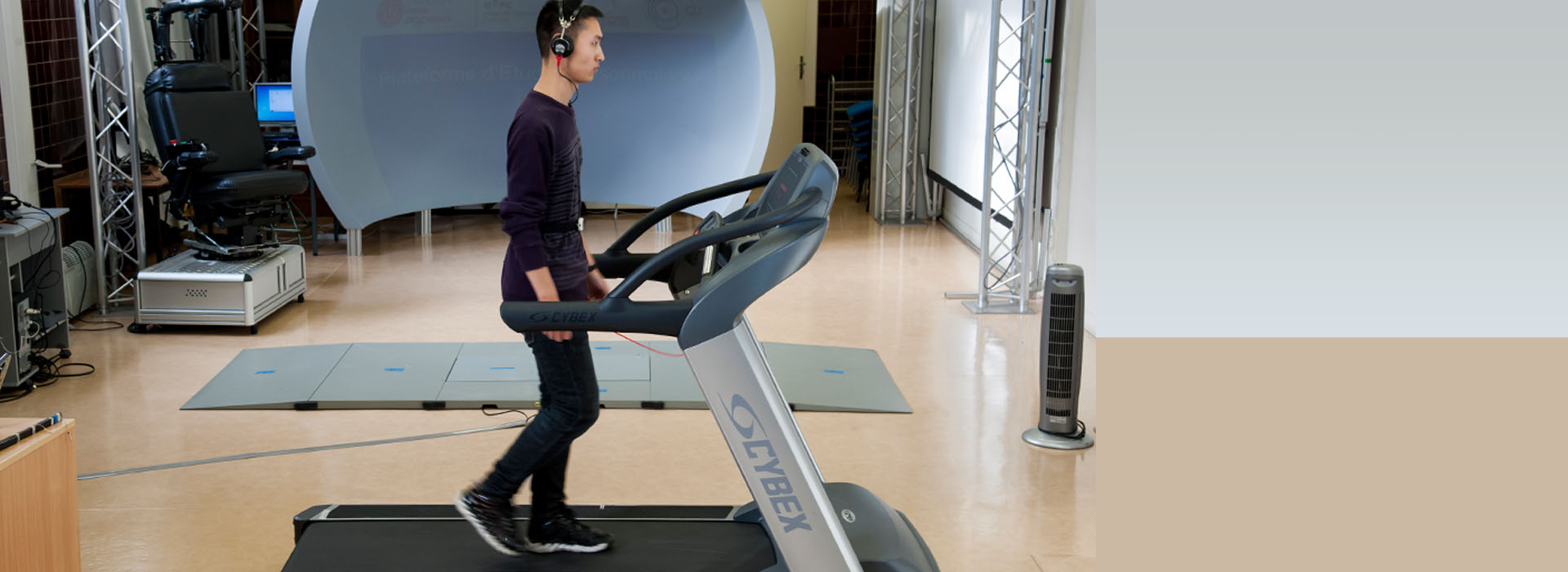RESEARCH AND DEVELOPMENT ((UMR 9010 PARIS DESCARTES UNIVERSITY AND ENS PARIS SACLAY 4)
1. DEVELOPMENT OF NEW BALANCE TESTS
Among the 10 receptors in the inner ear, some are still inaccessible. In collaboration with the best international specialists, we are developing new exploration techniques which should lead to a better understanding of the complaints described by patients.
VISUAL DEPENDENCE
Balance depends on three sensory inputs: vestibular, visual, and proprioceptive.
With age or following a vestibular incident (vertigo), the patient can become visual-dependent. We have developed a diagnostic test with a virtual reality headset. This allows us to appreciate the fragility of balance when visual information is brought to the fore.
The subject is placed on a foam mat and an accelerometer placed behind his/her back using a belt. This allows the quality of his/her balance in X, Y Z to be fully appreciated when a visual image is moving in the helmet.
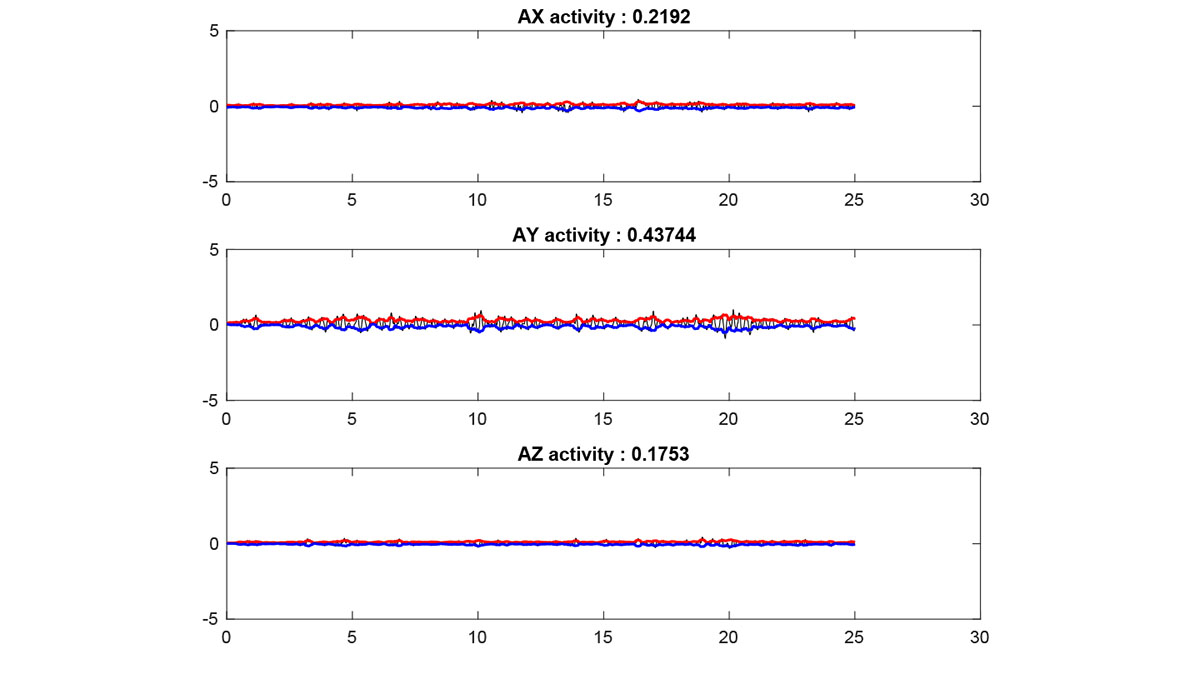
This patient has good balance. He/she remains on the foam mat for 25 seconds without oscillations regardless of the considered X, Y and Z axes.
Induced visual instabilities:
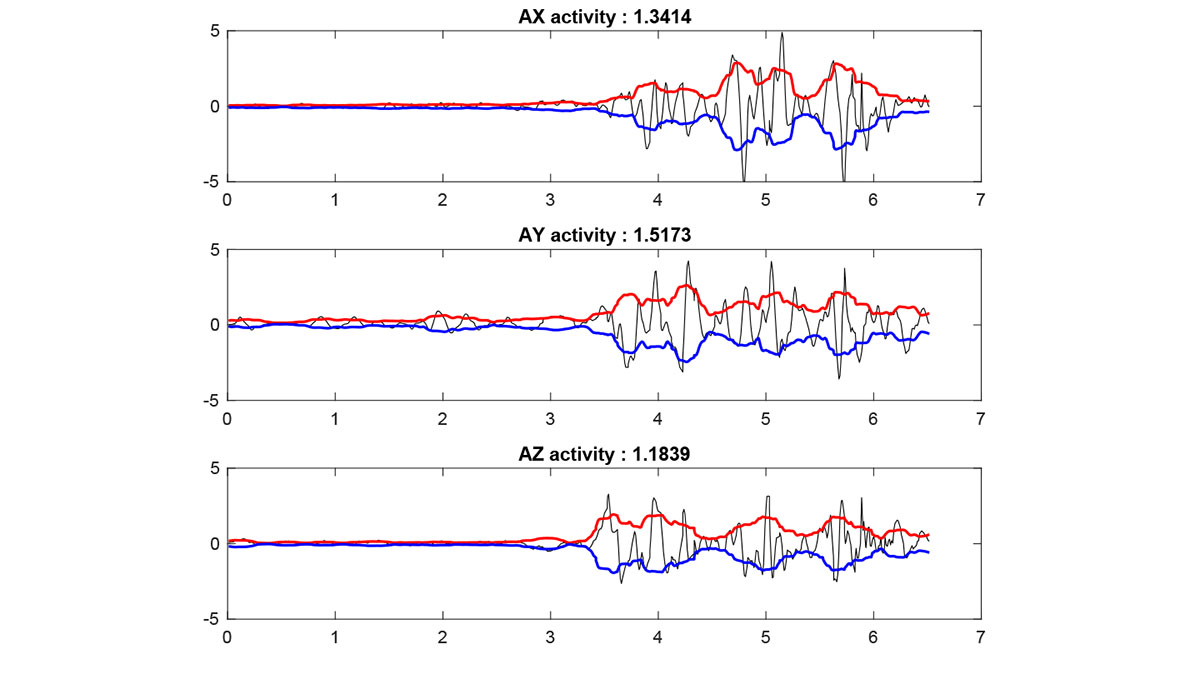
This patients doesn’t last 25 seconds on the foam mat. He/she experienced great postural oscillations and finally came off the foam mat before the end of the examination (7 seconds instead of 25 seconds).
MUSCLE STRENGTH
The muscle strength of the quadricep muscles is also part of the postural balance. Muscle strength, and particularly phasic fibre activity, has been shown to decrease with age, starting at age 40. Quantifying it is difficult.
We do this by using an accelerometer placed behind the patient's back as they perform ten sit / stand positions. Here is an example of traces obtained. A patient who has little muscle strength will be unable to hold back their descent towards the chair.
WALKING AND TURNING AROUND
Stability during slow walking and the ease of turning around are important factors to take into account.
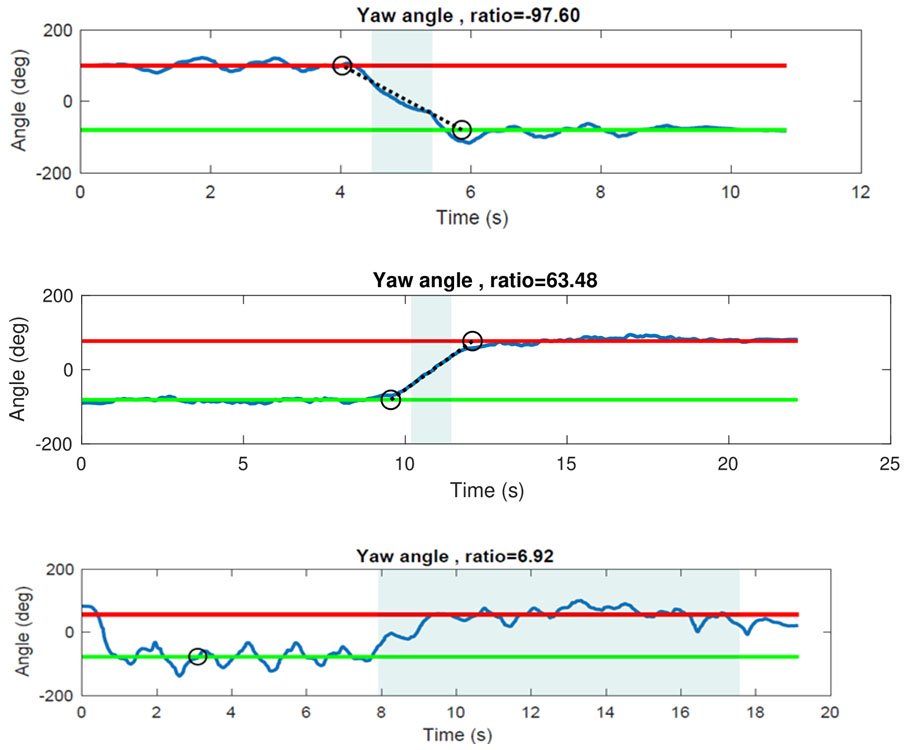
2. Development of new therapeutic strategies for patients suffering from balance disorders
These studies are performed on the Cognitive and Action Group’s sensorimotricity platform (Paris Descartes Faculty). The efficient software used (codamotion) studies the patient’s steps, falls and balance disorders.
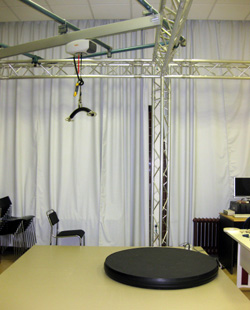
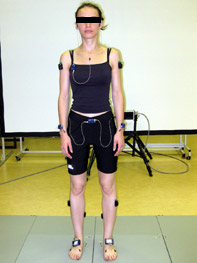
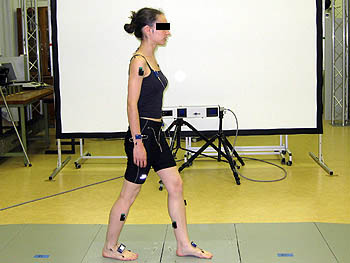
Falls / unsteadiness and inner ear function 11
French demographics are unequivocal: the population is ageing. According to INSEE, on January 1, 2011, people aged over 65 accounted for 17% (Total population by gender and age on January 1, 2011 by age group - scope: Metropolitan France. Source: Insee, population estimates - provisional results to the end of 2010) of the French population but the first generation of baby boomers (people born in 1946) has not yet reached the age of 65. In 2011, over 180,000 people are expected to reach the age of 65 (0.3% of the French population). (Total population by gender and age on January 1, 2011 by year of birth - scope: Metropolitan France. Source: Insee, population estimates (provisional results to the end of 2010).
This said, people aged over 65 are particularly at risk of home and leisure injuries (HLIs). Indeed, the 2009 results of the ongoing survey on home and leisure injuries show that 13.5% of HLIs involve people aged over 65. The most common type of HLI is falls (results of the ongoing survey on home and leisure injuries 1999-2001, EPAC network), which, on average, account for more than 82% of HLIs among the elderly.
Fall studies
A fall is defined as the act of falling inadvertently on the ground or other lower level, with or without loss of consciousness, and for a reason other than the sudden onset of paralysis or an epileptic seizure, excess alcohol intake or overwhelming external force (Close J, Ellis M, Hooper R, Glucksman E, Jackson S, Swift C. Prevention of falls in the elderly trial (PROFET): a randomised, controlled trial. Lancet. 1999 Jan. 9;353(9147):93-97.).
a - Consequences
Post-fall complications in the elderly are much more common than in younger people. The consequences can be more or less serious but the older the person, the more serious the fall is. (Social repercussions – Falls: facts and figures - Protec-fall [Internet]. [quoted 2011 June 2] Available from: http://www.protec-chute.com/chute-en-question/28/les-cons-ences-sociales.html).
The immediate repercussions range from simple bruising to severe traumas such as fractures (only 8% of falls result in fractures). The secondary repercussions stem from the elderly person being immobilized after the fall. There is a distinction between psychomotor repercussions and social repercussions. Psychomotor repercussions stem from a post-fall syndrome, which causes anxiety when the person walks and a fear of falling. With this syndrome the patient experiences problems with balance, walking, cognition and reduced mobility (Vellas BJ, Wayne SJ, Romero LJ, Baumgartner RN, Garry PJ. Fear of falling and restriction of mobility in elderly fallers. Age Ageing. 1997 May; 26(3):189-193). This leads to significant psychomotor retardation which can cause a decrease in postural adaptation reactions.
The social repercussions are related to the elderly person’s loss of independence, which is caused by the post-fall syndrome or by functional injuries from the fall. This results in a decrease in usual activities within 8 weeks of the fall (Grisso JA, Schwarz DF, Wolfson V, Polansky M, LaPann K. The impact of falls in an inner-city elderly African-American population. J Am Geriatr Soc. 1992 Jul;40(7):673-678.) and an increased risk of being institutionalized (Kiel DP, O’Sullivan P, Teno JM, Mor V. Health care utilization and functional status in the aged following a fall. Med Care. 1991 March;29(3):221-228.).
Falls therefore have serious consequences in terms of mortality and morbidity in the elderly. The psychological repercussions are important to consider, especially the post-fall syndrome, as it undermines the person’s autonomy and increases the risk of institutionalization.
b- Causes
There are often multiple factors involved. There are two major factors determining falls: intrinsic factors related to the person and extrinsic factors related to the environment.
Intrinsic factors
With ageing, there is a functional decline in physiological factors that increases the risk of falling. For example, there is a deterioration in eyesight, proprioception, muscle strength and central reaction time (NHMRC(National Health and Medical Research Council - Australia) - Falls and the older person Series on Clinical Management Problems in the Elderly 1993; 6: 1-26.)
In addition, a number of common diseases in the elderly worsen this functional decline. These include vestibular conditions responsible for balance disorders, dizziness and even hypotension (Société Scientifique de Médecine Générale SSMG asbl Best Practice Recommendations PREVENTION OF FALLS AMONG THE ELDERLY SSMG - IRE 2000 Last revised: October 2000).
Extrinsic factors
These are factors related to the environment, according to the results of the 2004 and 2005 EPAC. Falls mainly occur within the home (78% of falls) but the circumstances and objects involved vary greatly (flooring, stairs, chair, bed, slippers, etc.).
These are also factors related to the activity just before the fall. The most common activity before a fall is walking (69%). (State of health of the population in France – Follow-up to objectives appended to the Public Health Act - 2009-2010 report). In addition, activities that were never a problem become a risk factor for falls due to ageing.
c - Risk factors
Intrinsic risk factors are presented in Table 1 below with their level of evidence (Lachs MS, Feinstein AR, Cooney LM Jr, Drickamer MA, Marottoli RA, Pannill FC, et al. A simple procedure for general screening for functional disability in elderly patients. Ann. Intern. Med. 1990 May 1;112(9):699-706; Stuck AE, Walthert JM, Nikolaus T, Büla CJ, Hohmann C, Beck JC. Risk factors for functional status decline in community-living elderly people: a systematic literature review. Soc Sci Med. 1999 Feb;48(4):445-469. Société Scientifique de Médecine Générale Best Practice Recommendations Revision summary (March 2008).
Table 1 - Risk factors for falls
| Risk factor | Level of evidence |
| Mobility disorders (balance, walking, muscle strength disorders) | 1 |
| Fall(s) over the previous year | 2 |
| Use of a psychotropic drug | 2 |
| Requires assistance for activities of daily living (ADL) | 3 |
| Preventive effect of physical activity | 3 |
| Visual impairment | 3 |
| Urinary incontinence | 3 |
| Parkinsons disease' | 3 |
| Foot problems (calluses, toe deformities) | 3 |
| Unsteadiness | 4 relationship uncertain |
| Multiple medications | 4 |
| Age | 4 not proven |
| Gender | 4 relationship uncertain |
| Depressive symptoms | 4 relationship uncertain |
| Cognitive impairment | 4 relationship uncertain |
| Fear of falling | 4 relationship uncertain |
| History of stroke | 4 |
Level of evidence:
1. 75-100% of the articles show that the factor is an independent risk for at least 3 studies.
2. 50-75% of the articles show that the factor is an independent risk for at least 3 studies.
3. 25-50% of the articles show that the factor is an independent risk and/or this risk factor was assessed twice;
4. 0-25% of the articles show that the factor is an independent risk and/or this risk factor was assessed only once.
Extrinsic risk factors are mainly insufficient lighting, rugs, uneven flooring, the absence of a handrail, obstructions in hallways and passageways and access to objects, especially high up. (Best Practice Recommendations SSMG - IRE 2000)
Falls among the elderly therefore stem from multiple factors and several analyses reveal multiple risk factors on which fall prevention is based. In addition, note that the increased risk of falling has a linear correlation with the number of risk factors: there is an 8% risk without risk factors and a 78% risk when there are more than 3 risk factors present (Tinetti ME, Speechley M, Ginter SF. Risk factors for falls among elderly persons living in the community. N. Engl. J. Med. 1988 Dec 29;319(26):1701-1707.
In Conclusion
Developing such studies will improve the living conditions of elderly patients and reduce the health costs related to potential falls and their functional consequences.
The new tests will make it possible to monitor the efficacy of new drugs and new treatment strategies.
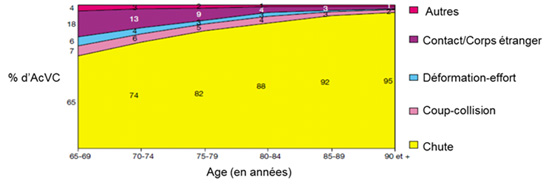
Breakdown of HLIs by mechanism, according to age
The incidence of falls reported among the elderly over the last 12 months is 23.8%, according to the 2005 Health Barometer (2005 Health Barometer – Health attitudes and behaviours). In the literature, according to a review of 62 randomized controlled trials studying interventions for preventing falls (Gillespie LD, Gillespie WJ, Robertson MC, Lamb SE, Cumming RG, Rowe BH. Interventions for preventing falls in elderly people. Cochrane Database Syst Rev. 2003;(4):CD000340), each year 30% of elderly people living at home experience at least one fall.
A fall can have more or less serious consequences and the EPAC survey estimates that in France in 2004, 4.5% of the elderly suffered a fall and were taken to hospital, i.e. 450,000 falls per year (Several hundreds of thousands of falls in elderly people each year in France Cécile Ricard (c.ricard@invs.sante.fr), Bertrand Thélot, Institut de veille sanitaire, Saint-Maurice, France). Figure 2 shows the proportion of falls broken down by follow-up after arriving at the hospital. State of health of the population in France - Follow-up to objectives appended to the Public Health Act - 2009-2010 report).
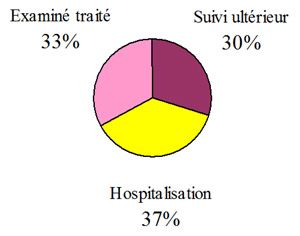
Breakdown of falls in the elderly by treatment
The 2006 InVS report (Mortality through Home and Leisure Injuries in Metropolitan France, 2000-2002, Institut de veille sanitaire, Saint-Maurice, France 2 / CépiDC Inserm, Le Vesinet, France) observes that falls are the leading cause of death by HLI in 2002 for all ages: 64% of deaths from HLIs are caused by a fall, i.e. a mortality rate of 7.5 in 100,000 per year, taking into account the fall only as the main cause of death. Mortality through Home and Leisure Injuries in Metropolitan France, 2000-2002, Institut de veille sanitaire, Saint-Maurice, France 2 / CépiDC Inserm, Le Vesinet, France.
Moreover, in 2004 CépiDc observed that 4,385 people over 65 died as a result of a fall, i.e. a fall mortality rate of 44.2 in 100,000 per year in Metropolitan France. State of health of the population in France - Follow-up to objectives appended to the Public Health Act - 2009-2010 report.
Falls among the elderly have therefore become a major public health issue, so much so that the objectives appended to the Act of August 9, 2004 on public health policy state that the number of falls in people over 65 must be reduced by 25% over the next four years and that more scientific knowledge is required on the circumstances and factors determining falls.
